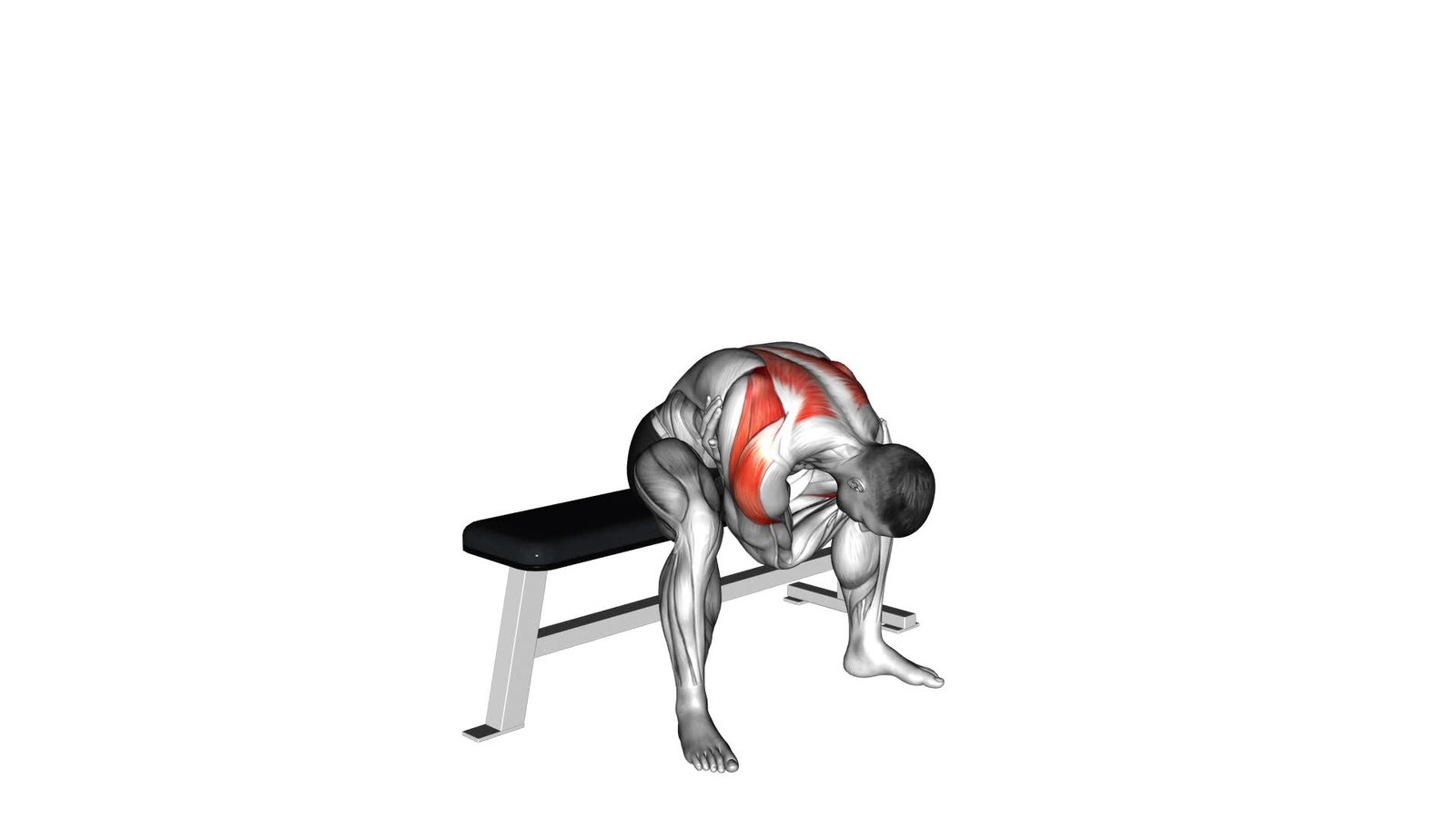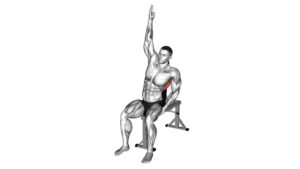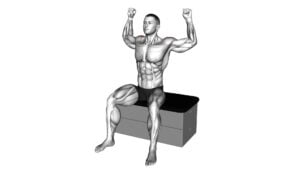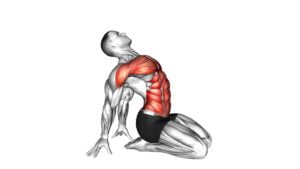Seated Rhomboid Stretch (male) – Video Exercise Guide & Tips

Are you looking to improve your flexibility and strengthen your back muscles? The Seated Rhomboid Stretch is just what you need.
Watch This Exercise Video
In this video exercise guide, you'll learn the proper form and technique to effectively stretch your rhomboid muscles.
Avoid common mistakes and discover modifications for beginners or advanced variations for experienced gym-goers.
Get ready to maximize the effectiveness of your stretch and achieve optimal results.
Let's get started!
Key Takeaways
- Seated Rhomboid Stretch improves posture and flexibility.
- It targets the rhomboid muscles and counters the effects of slouching.
- Regular practice reduces the risk of chronic pain or discomfort.
- Beginners can modify the stretch by using props or easing into it gradually.
Benefits of the Seated Rhomboid Stretch
To maximize the benefits of the Seated Rhomboid Stretch, focus on engaging your shoulder blades. This exercise is highly effective in improving posture and increasing flexibility. By targeting the muscles between your shoulder blades, known as the rhomboids, this stretch helps to counteract the effects of slouching and sitting for long periods of time. Engaging your shoulder blades during the stretch activates these muscles, allowing for a deeper and more effective stretch.
By regularly incorporating the Seated Rhomboid Stretch into your routine, you can improve your posture by strengthening the muscles responsible for pulling your shoulders back and down. This can help alleviate the strain on your neck and upper back, reducing the risk of developing chronic pain or discomfort. Additionally, the increased flexibility in your upper back and shoulders can enhance your overall range of motion and make daily activities, such as reaching or lifting, easier and more comfortable.
Now that you understand the benefits of the Seated Rhomboid Stretch, let's move on to discussing proper form and technique to ensure you're performing it correctly and safely.
Proper Form and Technique
To perform the Seated Rhomboid Stretch correctly and safely, ensure that your back is straight and engage your shoulder blades. This will help you target the rhomboid muscles effectively and avoid potential injuries.
One common misconception about this stretch is that you should round your shoulders forward, but this is incorrect. Instead, keep your shoulders pulled back and down, maintaining a relaxed posture. This will help you achieve a deeper stretch and engage the rhomboids more effectively.
When it comes to the recommended frequency of the Seated Rhomboid Stretch, aim to incorporate it into your routine at least two to three times per week. This will help improve your posture and alleviate any tension or tightness in the rhomboid muscles. However, it's important to listen to your body and not overdo it. If you experience any pain or discomfort during the stretch, ease off and adjust your position accordingly.
Common Mistakes to Avoid
Make sure to steer clear of these common mistakes when performing the Seated Rhomboid Stretch. Many people make errors that can diminish the effectiveness of the stretch or even lead to injury.
One common mistake is rounding your back instead of keeping it straight. This reduces the stretch in the rhomboid muscles and puts unnecessary strain on your spine.
Another mistake is pulling too hard on your arms, which can cause strain in the shoulders and neck. Remember, the stretch should be gentle and controlled.
Additionally, avoid holding your breath during the stretch. Instead, focus on taking slow, deep breaths to help relax your muscles and increase the effectiveness of the stretch.
Lastly, be mindful of your posture throughout the exercise. Slouching or hunching over can compromise the stretch and lead to improper alignment.
By avoiding these common mistakes, you can ensure that you're getting the most out of the Seated Rhomboid Stretch without risking injury.
Now, let's explore modifications for beginners to help you ease into this stretch.
Modifications for Beginners
Are you new to the Seated Rhomboid Stretch and looking for modifications to make the exercise more accessible for beginners? Don't worry, we've got you covered! Here are some beginner modifications that will help you ease into this stretch and avoid any unnecessary strain or discomfort.
Firstly, if you find it difficult to sit on the floor with your legs extended, you can try sitting on a yoga block or a cushion to elevate your hips. This will provide some extra support and make it easier for you to maintain proper form throughout the stretch.
Additionally, if reaching your hands behind your back is challenging, you can use a strap or a towel to bridge the gap. Simply hold onto the strap with both hands and gradually increase the tension as you become more comfortable with the stretch.
Furthermore, if you're unable to keep your back straight, you can bend your knees slightly to alleviate any excess strain on your lower back. Remember, it's important to listen to your body and only go as far as feels comfortable for you.
Advanced Variations for Experienced Gym-goers
Ready to take your Seated Rhomboid Stretch to the next level? If you're an experienced gym-goer looking for a challenge, there are advanced modifications and alternative stretches you can try. These variations will help you further engage your rhomboid muscles and enhance your flexibility.
One advanced modification you can incorporate is the Seated Rhomboid Stretch with Resistance Bands. To do this, attach a resistance band to a stationary object and hold the other end with both hands. Sit on the floor with your legs extended in front of you, and lean back slightly. Pull the resistance band towards your chest, squeezing your shoulder blades together as you do so. Hold the stretch for a few seconds before releasing.
Another option for advanced gym-goers is the Standing Rhomboid Stretch. Stand with your feet shoulder-width apart and extend your arms straight in front of you at shoulder height. Cross your right arm over your left and interlock your fingers. Rotate your hands away from you, feeling a stretch in your upper back and shoulders. Hold for a few seconds, then switch sides.
Remember to always listen to your body and never push yourself beyond your limits. If you experience any pain or discomfort, stop the exercise immediately. Incorporating these advanced modifications and alternative stretches into your routine will help you continue challenging your muscles and improving your flexibility.
Tips for Maximizing the Effectiveness of the Stretch
To maximize the effectiveness of the seated rhomboid stretch, focus on maintaining proper body alignment throughout the exercise. Keep your spine straight, shoulders relaxed, and avoid slouching.
Additionally, pay attention to your breathing technique by inhaling deeply and exhaling slowly as you perform the stretch.
These small adjustments will help you get the most out of this stretch and target your rhomboid muscles more effectively.
Proper Body Alignment
To achieve maximum effectiveness in this stretch, position your body correctly. Proper body alignment is crucial for targeting the rhomboid muscles and ensuring efficient muscle activation. Here are some tips to help you maintain the right posture:
- Sit up straight with your spine aligned.
- Keep your shoulders relaxed and away from your ears.
- Engage your core muscles by pulling your belly button towards your spine.
- Maintain a neutral head position, avoiding any excessive tilting or leaning.
By following these guidelines, you'll optimize the stretch and prevent unnecessary strain on other muscles.
Breathing Techniques
To maximize the effectiveness of the seated rhomboid stretch and optimize muscle activation, focus on coordinating your breathing with the movement. Incorporating proper breathing techniques can enhance the stretch and promote relaxation.
As you begin the stretch, take a deep breath in and exhale slowly as you lean forward. This exhalation helps to engage the muscles in your back and shoulders, allowing for a deeper stretch.
As you hold the stretch, continue to breathe deeply and evenly, focusing on relaxing any tension in your body. By using breathing exercises and relaxation techniques, you can enhance the effectiveness of the seated rhomboid stretch and promote a greater sense of calm and well-being.
Frequently Asked Questions
How Often Should I Perform the Seated Rhomboid Stretch to See Results?
To see results from the seated rhomboid stretch, it's important to perform it regularly. Incorporating this stretch into your daily routine can bring several benefits, such as improved posture and reduced back and shoulder pain.
To maximize its effectiveness, make sure to maintain proper form and hold the stretch for at least 30 seconds. Remember to breathe deeply and relax your shoulders while performing the stretch.
Consistency is key, so aim to do it at least three to four times a week.
Can the Seated Rhomboid Stretch Help Improve My Posture?
Improving your posture is a common goal, and the seated rhomboid stretch can help you achieve it. This stretch specifically targets the rhomboid muscles, which play a key role in maintaining proper posture.
By regularly performing this stretch, you can strengthen and lengthen these muscles, leading to improved posture over time.
The seated rhomboid stretch offers various benefits, including relieving tension in the upper back and shoulders.
Is It Normal to Feel Some Discomfort or Tension While Performing the Stretch?
Feeling discomfort or tension during the seated rhomboid stretch is normal. As you perform the stretch, it's common to experience some discomfort or tension in the targeted muscles. This is a sign that the stretch is working and targeting the right areas.
However, it's important to listen to your body and not push yourself too far. If the discomfort becomes painful, it's advisable to stop and consult a healthcare professional for guidance.
Are There Any Precautions or Contraindications for Performing the Seated Rhomboid Stretch?
When doing the seated rhomboid stretch, it's important to be aware of any precautions or contraindications. Precautions are necessary to avoid potential injuries or aggravation of existing conditions.
Contraindications are situations where the stretch should be avoided altogether due to specific health concerns. Understanding these precautions and contraindications can help you perform the stretch safely and effectively.
It's always a good idea to consult with a healthcare professional if you have any doubts or concerns.
Can the Seated Rhomboid Stretch Be Beneficial for Individuals With Shoulder or Upper Back Injuries?
The seated rhomboid stretch can be beneficial for individuals with shoulder or upper back injuries. It's a great exercise for shoulder rehabilitation and can help improve range of motion and flexibility in the upper back.
By stretching the rhomboid muscles, it can alleviate tension and tightness in the shoulders and upper back, promoting healing and recovery.
Incorporating the seated rhomboid stretch into your routine can be a helpful addition to your rehabilitation program.
Conclusion
In conclusion, the seated rhomboid stretch is a beneficial exercise for improving flexibility and relieving tension in the upper back and shoulders. By following proper form and technique, and avoiding common mistakes, you can maximize the effectiveness of this stretch.
Beginners can modify the exercise to suit their level of fitness, while advanced gym-goers can explore variations for added challenge. Remember to always listen to your body and consult with a professional if needed.

Author
Years ago, the spark of my life’s passion ignited in my mind the moment I stepped into the local gym for the first time. The inaugural bead of perspiration, the initial endeavor, the very first surge of endorphins, and a sense of pride that washed over me post-workout marked the beginning of my deep-seated interest in strength sports, fitness, and sports nutrition. This very curiosity blossomed rapidly into a profound fascination, propelling me to earn a Master’s degree in Physical Education from the Academy of Physical Education in Krakow, followed by a Sports Manager diploma from the Jagiellonian University. My journey of growth led me to gain more specialized qualifications, such as being a certified personal trainer with a focus on sports dietetics, a lifeguard, and an instructor for wellness and corrective gymnastics. Theoretical knowledge paired seamlessly with practical experience, reinforcing my belief that the transformation of individuals under my guidance was also a reflection of my personal growth. This belief holds true even today. Each day, I strive to push the boundaries and explore new realms. These realms gently elevate me to greater heights. The unique combination of passion for my field and the continuous quest for growth fuels my drive to break new ground.



